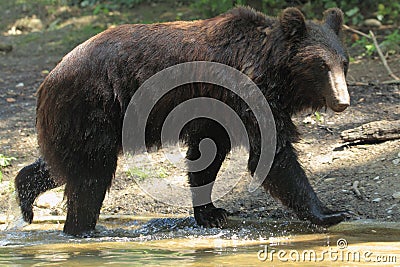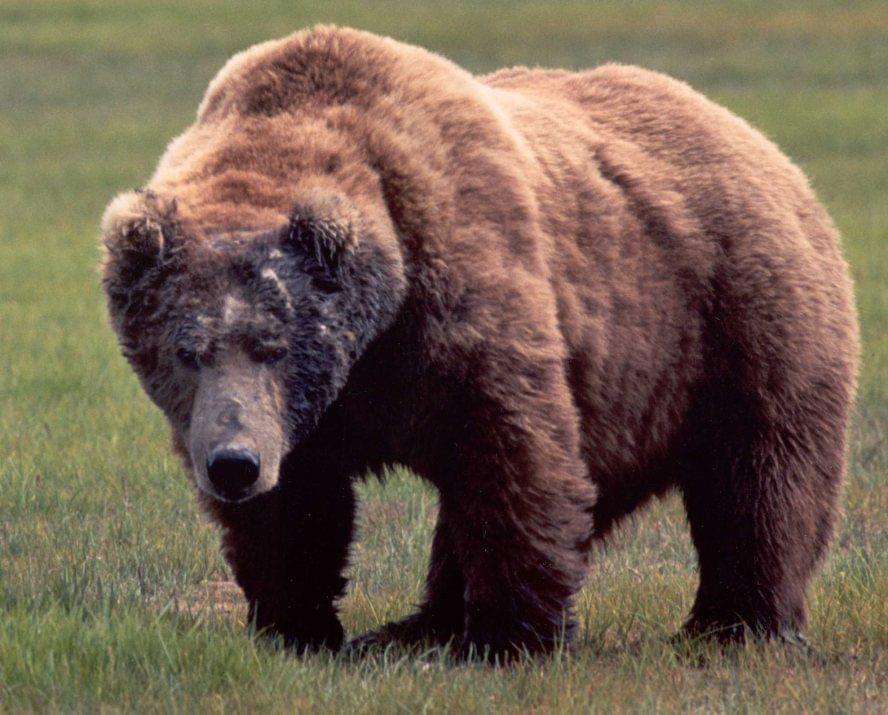Post by DonaldCengXiongAzuma on Jan 3, 2020 6:27:17 GMT 5
Grizzly Bear - Ursus arctos horribilis
The grizzly bear (Ursus arctos horribilis), also known as the silvertip bear, the grizzly, or the North American brown bear, is a subspecies of brown bear (Ursus arctos) that generally lives in the uplands of western North America. This subspecies is thought to descend from Ussuri brown bears which crossed to Alaska from eastern Russia 100,000 years ago, though they did not move south until 13,000 years ago. Except for cubs and females, grizzlies are normally solitary, active animals, but in coastal areas, the grizzly congregates alongside streams, lakes, rivers, and ponds during the salmon spawn. Every other year, females (sows) produce one to four young (commonly two) which are small and weigh only about 500 grams (1 lb). A sow is protective of her offspring and will attack if she thinks she or her cubs are threatened. The word "grizzly" in its name refers to "grizzled" or grey hairs in its fur, but when naturalist George Ord formally named the bear in 1815, he misunderstood the word as "grisly", to produce its biological Latin specific or subspecific name "horribilis". Most adult female grizzlies weigh 130–200 kilograms (290–440 lb), while adult males weigh on average 180–360 kilograms (400–790 lb). The average total length in this subspecies is 198 centimetres (6.50 ft), with an average shoulder height of 102 centimetres (3.35 ft) and hindfoot length of 28 centimetres (11 in). Newborn bears may weigh less than 500 grams (1 lb). In the Yukon River area, mature female grizzlies can weigh as little as 100 kilograms (220 lb). On the other hand, an occasional huge male grizzly has been recorded which greatly exceeds ordinary size, with weights reported up to 680 kilograms (1,500 lb). Although variable from blond to nearly black, grizzly bear fur is typically brown in color with white tips. A pronounced hump appears on their shoulders; the hump is a good way to distinguish a black bear from a grizzly bear, as black bears do not have this hump.
Credited to Dinosaur Michael.
Read more: theworldofanimals.proboards.com/thread/180/bengal-tiger-grizzly-bear?page=1#ixzz69vV6dK8w

Credited to Brobear.
Ussuri Brown Bear - Ursus arctos lasiotus
The Ussuri brown bear (Ursus arctos lasiotus), also known as the black grizzlyis a subspecies of the brown bear found in the Ussuri krai, Sakhalin, the Amur Oblast, northward to the Shantar Islands, Iturup Island, northeastern China, the Korean peninsula, Hokkaid? and Kunashiri Island. This subspecies is thought to be the ancestor of the North American grizzly bear. Ussuri brown bears crossed to Alaska 100,000 years ago, though they did not move south until 13,000 years ago. The Ainu people worshipped the Ussuri brown bear, eating its flesh and drinking its blood as part of a religious festival known as iomante. It is very similar to the Kamchatka brown bear, though it has a more elongated skull, a less elevated forehead, somewhat longer nasal bones and less separated zygomatic arches, and is somewhat darker in color, with some individuals being completely black, a fact which once led to the now refuted speculation that black individuals were hybrids of brown bears and Asian black bears. Adult males have skulls measuring 38.7 cm long and 23.5 cm wide. They can occasionally reach greater sizes than their Kamchatka counterparts: the largest skull measured by Sergej Ognew (1931) was only slightly smaller than that of the largest Alaskan bear on record at the time. In Sikhote Alin, Ussuri brown bears den mostly in burrows excavated into hillsides, though they will on rarer occasions den in rock outcroppings or build ground nests. These brown bears rarely encounter Asian black bears, as they den at higher elevations and on steeper slopes than the latter species. They may on rare occasions attack their smaller black cousins. In middle Sakhalin in spring, brown bears feed on the previous year's red bilberry, ants and flotsam, and at the end of the season, they concentrate on the shoots and rhizomes of tall grasses. On the southern part of the island, they feed primarily on flotsam, as well as insects and maple twigs. In springtime in Sikhote Alin, they feed on acorns, Manchurian walnuts and Korean nut pine seeds. In times of scarcity, in addition to bilberries and nuts, they capture larvae, wood-boring ants and lily roots. In early summer, they will strip bark from white-barked fir trees and feed on their cambium and sap. They will also eat berries from honeysuckle, yew, Amur grapevine and buckthorn. In southern Sakhalin, their summer diet consists of currents and chokeberries are eaten. In the August period in the middle part of the island, fish comprise 28% of their diet. In Hokkaido, the brown bear has a diet including small and large mammals, fish, birds and insects such as ants.

Info and picture credited to Modercai
Read more: theworldofanimals.proboards.com/thread/483/ussuri-brown-bear-siberian-tiger?page=1#ixzz69vVAjcoh
The grizzly bear (Ursus arctos horribilis), also known as the silvertip bear, the grizzly, or the North American brown bear, is a subspecies of brown bear (Ursus arctos) that generally lives in the uplands of western North America. This subspecies is thought to descend from Ussuri brown bears which crossed to Alaska from eastern Russia 100,000 years ago, though they did not move south until 13,000 years ago. Except for cubs and females, grizzlies are normally solitary, active animals, but in coastal areas, the grizzly congregates alongside streams, lakes, rivers, and ponds during the salmon spawn. Every other year, females (sows) produce one to four young (commonly two) which are small and weigh only about 500 grams (1 lb). A sow is protective of her offspring and will attack if she thinks she or her cubs are threatened. The word "grizzly" in its name refers to "grizzled" or grey hairs in its fur, but when naturalist George Ord formally named the bear in 1815, he misunderstood the word as "grisly", to produce its biological Latin specific or subspecific name "horribilis". Most adult female grizzlies weigh 130–200 kilograms (290–440 lb), while adult males weigh on average 180–360 kilograms (400–790 lb). The average total length in this subspecies is 198 centimetres (6.50 ft), with an average shoulder height of 102 centimetres (3.35 ft) and hindfoot length of 28 centimetres (11 in). Newborn bears may weigh less than 500 grams (1 lb). In the Yukon River area, mature female grizzlies can weigh as little as 100 kilograms (220 lb). On the other hand, an occasional huge male grizzly has been recorded which greatly exceeds ordinary size, with weights reported up to 680 kilograms (1,500 lb). Although variable from blond to nearly black, grizzly bear fur is typically brown in color with white tips. A pronounced hump appears on their shoulders; the hump is a good way to distinguish a black bear from a grizzly bear, as black bears do not have this hump.
Credited to Dinosaur Michael.
Read more: theworldofanimals.proboards.com/thread/180/bengal-tiger-grizzly-bear?page=1#ixzz69vV6dK8w

Credited to Brobear.
Ussuri Brown Bear - Ursus arctos lasiotus
The Ussuri brown bear (Ursus arctos lasiotus), also known as the black grizzlyis a subspecies of the brown bear found in the Ussuri krai, Sakhalin, the Amur Oblast, northward to the Shantar Islands, Iturup Island, northeastern China, the Korean peninsula, Hokkaid? and Kunashiri Island. This subspecies is thought to be the ancestor of the North American grizzly bear. Ussuri brown bears crossed to Alaska 100,000 years ago, though they did not move south until 13,000 years ago. The Ainu people worshipped the Ussuri brown bear, eating its flesh and drinking its blood as part of a religious festival known as iomante. It is very similar to the Kamchatka brown bear, though it has a more elongated skull, a less elevated forehead, somewhat longer nasal bones and less separated zygomatic arches, and is somewhat darker in color, with some individuals being completely black, a fact which once led to the now refuted speculation that black individuals were hybrids of brown bears and Asian black bears. Adult males have skulls measuring 38.7 cm long and 23.5 cm wide. They can occasionally reach greater sizes than their Kamchatka counterparts: the largest skull measured by Sergej Ognew (1931) was only slightly smaller than that of the largest Alaskan bear on record at the time. In Sikhote Alin, Ussuri brown bears den mostly in burrows excavated into hillsides, though they will on rarer occasions den in rock outcroppings or build ground nests. These brown bears rarely encounter Asian black bears, as they den at higher elevations and on steeper slopes than the latter species. They may on rare occasions attack their smaller black cousins. In middle Sakhalin in spring, brown bears feed on the previous year's red bilberry, ants and flotsam, and at the end of the season, they concentrate on the shoots and rhizomes of tall grasses. On the southern part of the island, they feed primarily on flotsam, as well as insects and maple twigs. In springtime in Sikhote Alin, they feed on acorns, Manchurian walnuts and Korean nut pine seeds. In times of scarcity, in addition to bilberries and nuts, they capture larvae, wood-boring ants and lily roots. In early summer, they will strip bark from white-barked fir trees and feed on their cambium and sap. They will also eat berries from honeysuckle, yew, Amur grapevine and buckthorn. In southern Sakhalin, their summer diet consists of currents and chokeberries are eaten. In the August period in the middle part of the island, fish comprise 28% of their diet. In Hokkaido, the brown bear has a diet including small and large mammals, fish, birds and insects such as ants.

Info and picture credited to Modercai
Read more: theworldofanimals.proboards.com/thread/483/ussuri-brown-bear-siberian-tiger?page=1#ixzz69vVAjcoh





